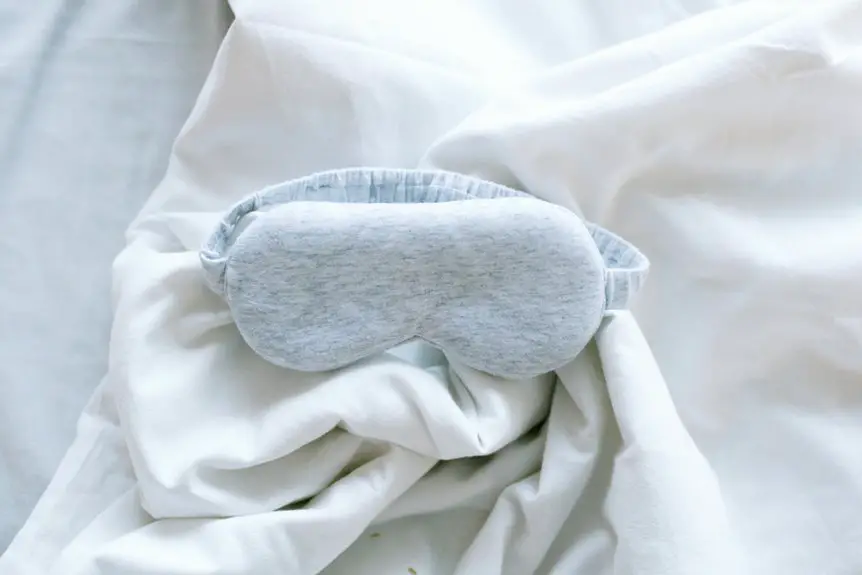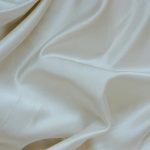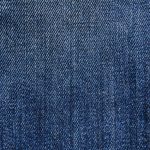Percale cotton is a crisp, tightly woven fabric known for its smooth, matte finish and cool feel—perfect if you want breathable, durable bedding or shirts. It’s made with at least 180 threads per square inch in a one-over-one-under pattern, giving it a clean, elegant look that lasts through many washes without pilling. Originating from South Asia, percale has evolved into a luxury favorite. Keep going to uncover what sets it apart and how to spot quality.
Table of Contents
Key Takeaways
- Percale cotton is a tightly woven fabric with at least 180 threads per square inch, known for its crisp, smooth texture and matte finish.
- It originated in South Asia and became popular in Europe during the 18th and 19th centuries for its durability and cool feel.
- The fabric is breathable, resistant to pilling, and maintains its crispness after multiple washes, making it ideal for bedding and shirts.
- Percale cotton is produced using a one-over-one-under weave, finished with processes like washing and mercerizing to enhance texture and durability.
- Caring for percale cotton involves ironing when slightly damp on medium to high heat without steam and ironing on the reverse side to preserve fabric quality.
Definition of Percale Cotton
Percale cotton is a type of closely woven fabric known for its crisp, smooth texture. When you touch percale, you’ll notice a matte finish and a cool feel, thanks to its tight weave.
Percale cotton offers a crisp, smooth texture with a matte finish and a refreshingly cool feel.
It’s made by weaving one thread over and under one thread in a simple, balanced pattern, typically with at least 180 threads per square inch. This dense weave makes the fabric durable and breathable, perfect for bedding and shirts.
You’ll appreciate how percale resists pilling and stays crisp even after multiple washes. Unlike other cotton fabrics, percale offers a lightweight, fresh sensation, making it ideal if you prefer a cooler, more breathable textile.
When you choose percale cotton, you’re opting for quality and comfort in one fabric.
History and Origin of Percale Weave
Although its exact beginnings are somewhat unclear, the percale weave has roots that trace back several centuries, evolving as artisans sought a durable yet breathable fabric. You’ll find that percale originated in South Asia, where skilled weavers perfected its tight, plain weave. Over time, it spread to Europe, gaining popularity for its crisp feel and longevity. Today, percale remains prized in bedding and apparel for these qualities.
| Time Period | Key Development |
|---|---|
| 17th Century | Origins in South Asian weaving |
| 18th-19th Century | Spread to Europe and refinement |
| Modern Day | Widely used in luxury bedding |
Understanding this background helps you appreciate percale’s blend of tradition and practicality.
How Percale Cotton Is Made
The rich history of percale fabric sets the stage for understanding how this fine textile comes to life.
Exploring percale’s rich history reveals the craftsmanship behind this exceptional fabric.
When you choose percale cotton, you’re selecting a fabric woven with a tight, one-over-one-under pattern. This weaving technique gives percale its signature smoothness and durability. It starts with high-quality cotton fibers that are spun into fine yarns.
These yarns are then woven on a loom, where the single threads cross each other at right angles. The result? A crisp, matte finish that feels cool to the touch.
After weaving, the fabric undergoes finishing processes, including washing and sometimes mercerizing, to enhance its strength and softness.
Characteristics of Percale Cotton Fabric
When you feel this fabric, you’ll notice its distinct crispness and smooth texture that sets it apart from other cotton weaves. Percale cotton offers a breathable, lightweight feel, making it perfect for warm nights.
It’s also durable, thanks to its tight weave, so it stands up well to frequent washing. You’ll appreciate its matte finish, which gives your bedding a clean, elegant look without any shine. Plus, it resists pilling and wrinkles better than many other fabrics.
Here are key characteristics of percale cotton fabric:
- Crisp and smooth touch
- Breathable and lightweight
- Durable and long-lasting
- Matte, non-shiny finish
- Resists pilling and wrinkles
These qualities make percale a favorite for those seeking comfort and style in their linens.
Comparing Percale Cotton to Other Weaves
If you’re choosing bedding, understanding how percale cotton compares to other weaves can help you pick the best fabric for your needs.
Percale features a tight, plain weave that gives it a crisp, matte finish, unlike sateen’s smooth, shiny surface created by a satin weave. You’ll find percale is more breathable and cooler than sateen, making it ideal if you sleep hot.
Percale’s tight plain weave offers a crisp, matte feel and breathability, perfect for hot sleepers.
Compared to flannel, which has a brushed, fuzzy texture, percale feels lighter and less warm, perfect for warmer climates.
Percale also tends to be more durable and less prone to pilling than jersey knit, which is stretchier but less structured.
Knowing these differences helps you decide if you want crisp coolness, softness, or warmth in your bedding fabric.
Benefits of Using Percale Cotton Bedding
Choosing percale cotton over other weaves brings several advantages that can enhance your sleep experience.
You’ll notice its crisp, cool feel right away, making it perfect for warm nights. Percale’s tight weave guarantees durability, so your bedding stays smooth and strong through countless washes.
It also breathes well, helping you stay comfortable by regulating temperature and moisture. Plus, percale cotton resists pilling, keeping your sheets looking new longer.
Finally, its lightweight nature means it won’t weigh you down, offering a revitalizing sleep surface.
- Breathable fabric keeps you cool
- Durable weave withstands frequent washing
- Crisp texture feels smooth against your skin
- Resists pilling and maintains appearance
- Lightweight for comfortable layering
These benefits make percale cotton a smart choice for quality bedding.
Ideal Uses for Percale Cotton
Percale cotton suits a variety of uses, especially where breathability and durability matter most.
If you want crisp, cool bedding that lasts, percale cotton sheets are perfect. They keep you comfortable on warm nights by allowing air to circulate freely. You’ll also appreciate percale for everyday bed linens in guest rooms or children’s rooms, thanks to its hard-wearing nature.
Beyond bedding, percale cotton works well for lightweight clothing like shirts and pajamas, offering a smooth feel without overheating.
If you’re into home décor, consider percale for pillowcases and duvet covers—they maintain a fresh, matte look.
How to Care for Percale Cotton Sheets
To keep your percale cotton sheets crisp and fresh, you’ll want to follow specific washing instructions that protect the fabric’s texture.
Drying them properly is just as important to prevent shrinkage and maintain softness.
Plus, knowing when and how to iron can help you keep your sheets looking smooth and inviting.
Washing Instructions
Although caring for percale cotton sheets may seem straightforward, following specific washing instructions guarantees they stay crisp and durable. You want to preserve their texture and avoid any premature wear, so pay close attention when washing.
- Use cold or warm water to prevent shrinking and maintain fabric integrity.
- Choose a gentle cycle to reduce stress on the fibers.
- Avoid bleach, which can weaken cotton and cause discoloration.
- Use mild detergent without fabric softeners, as softeners can coat fibers and reduce breathability.
- Wash sheets separately to prevent abrasion from zippers or buttons on other clothes.
Drying Tips
You should dry your cotton sheets carefully to keep them crisp and long-lasting. Avoid high heat, which can weaken fibers and cause shrinking. Instead, choose a low heat or air-dry setting to maintain the fabric’s integrity. Removing sheets promptly from the dryer prevents wrinkles and helps retain their smooth texture. If possible, line drying in a shaded area preserves color and freshness without sun damage.
| Drying Tip | Recommended Setting | Reason |
|---|---|---|
| Heat Level | Low or Air Dry | Prevents shrinking |
| Drying Time | Short Cycles | Reduces fiber wear |
| Removal Timing | Immediately | Minimizes wrinkles |
Follow these tips for percale sheets that stay crisp and comfortable night after night.
Ironing Guidelines
A crisp, smooth finish brings out the best in your percale cotton sheets, and ironing plays a key role in achieving that.
To keep your sheets looking fresh and wrinkle-free, follow these simple ironing guidelines. First, iron while the sheets are slightly damp for easier smoothing. Use a medium to high heat setting on your iron, but avoid steam if you want to prevent shrinking.
Always iron on the reverse side to protect the fabric’s surface. If you prefer, lightly spray the sheets with water before ironing to help remove stubborn creases.
Finally, fold or put them on your bed immediately after ironing to maintain that crisp look longer.
- Iron sheets when slightly damp
- Use medium to high heat setting
- Avoid steam to prevent shrinking
- Iron on the reverse side
- Fold or spread immediately after ironing
Common Misconceptions About Percale Cotton
Misunderstandings about percale cotton often lead people to overlook its true qualities. You might think percale is rough or stiff, but in reality, it’s known for its crisp, smooth feel that softens with each wash.
Some assume it wrinkles excessively, yet proper care keeps it looking fresh. Another common myth is that percale lacks durability; however, its tight weave enhances strength and longevity.
You may also hear that percale isn’t breathable, but it actually allows excellent air circulation, keeping you cool at night. Don’t confuse percale with sateen, as they’ve distinct textures and finishes.
Understanding these misconceptions helps you appreciate percale cotton’s unique benefits without misguided assumptions holding you back from enjoying it fully.
Percale Cotton Thread Count Explained
Understanding percale cotton’s qualities becomes clearer when you consider its thread count, a key factor influencing its texture and durability.
Thread count measures the number of horizontal and vertical threads per square inch of fabric. For percale cotton, this typically ranges between 180 and 200, striking a balance between softness and breathability.
Higher thread counts don’t always mean better quality; percale’s crisp feel comes from its plain weave rather than sheer density.
When choosing percale sheets, focus on:
- Thread count between 180-200 for true percale texture
- Tight, even weaving for durability
- Use of long-staple cotton for strength
- Breathability that keeps you cool at night
- Crisp, matte finish instead of a shiny surface
This knowledge helps you pick authentic, high-quality percale cotton bedding.
Environmental Impact of Percale Cotton Production
While percale cotton offers comfort and durability, its production also impacts the environment in several ways you should consider.
Growing cotton demands significant water, often straining local supplies, especially in drought-prone areas. You should also know that conventional cotton farming relies heavily on pesticides and synthetic fertilizers, which can harm soil health and nearby ecosystems.
Additionally, cotton cultivation contributes to soil degradation and erosion if not managed sustainably.
Processing percale cotton involves energy-intensive steps like spinning and weaving, which increase its carbon footprint.
If you want to reduce environmental harm, look for percale cotton labeled organic or sustainably grown, as these practices minimize chemical use and water consumption.
Understanding these impacts helps you make informed choices about the textiles you bring into your home.
Tips for Choosing Quality Percale Cotton Products
When you shop for percale cotton products, paying attention to thread count and fabric weave can help you spot quality.
Percale typically has a thread count between 200 and 400, offering a crisp feel without sacrificing breathability.
Look closely at the weave—it should be tight and uniform, ensuring durability and smoothness.
Don’t forget to check the cotton’s origin, as long-staple cotton usually means softer, stronger fabric.
Also, consider the finishing process; minimal chemical treatments preserve the fabric’s natural texture.
Finally, feel the fabric—quality percale feels cool and lightweight to the touch.
- Confirm thread count falls within 200–400 for ideal texture
- Inspect the weave for tightness and evenness
- Choose long-staple cotton for softness and strength
- Opt for products with minimal chemical finishes
- Test fabric feel for coolness and lightness
Frequently Asked Questions
Can Percale Cotton Be Blended With Other Fibers for Durability?
Blending percale cotton with other fibers is like mixing colors on a palette—you get durability without losing softness. You can combine it with polyester or linen to strengthen fabric while keeping that crisp, breathable feel you love.
Does Percale Cotton Shrink After Washing?
Yes, percale cotton can shrink slightly after washing, especially if you use hot water or high heat drying. You’ll want to wash it in cold water and air dry or tumble dry low to minimize shrinking.
Are Percale Cotton Sheets Suitable for People With Allergies?
Like a refreshing change in a Jane Austen novel, percale cotton sheets are naturally hypoallergenic and breathable. You’ll find they resist dust mites and allergens, making them a smart choice for sensitive sleepers like you.
How Long Do Percale Cotton Sheets Typically Last?
You can expect percale cotton sheets to last around 3 to 5 years with proper care. They’re durable, breathable, and get softer over time, so don’t forget to wash them gently and avoid harsh detergents.
Can Percale Cotton Fabric Be Used for Clothing?
Imagine wearing a crisp breeze—Percale cotton fabric wraps you in lightweight comfort. You’ll love it for clothing, especially shirts and dresses, since it’s breathable, durable, and feels fresh against your skin all day long.
- Does Chiffon Fabric Stink - July 15, 2025
- Does Chiffon Fabric Affect the Economy - July 15, 2025
- Does Cotton Fabric Have a Nap - July 15, 2025







